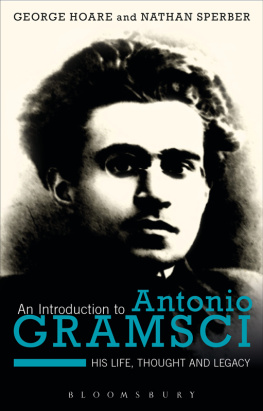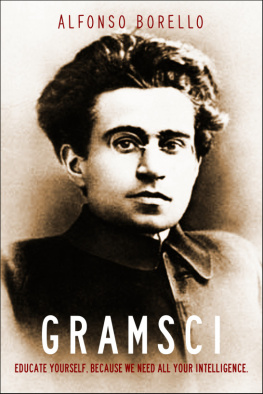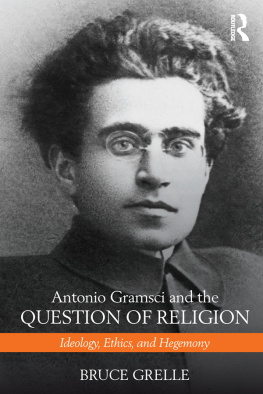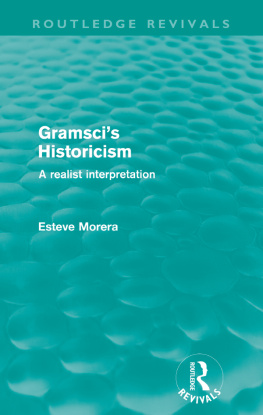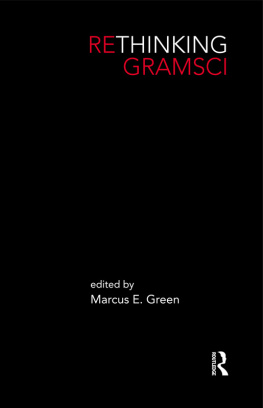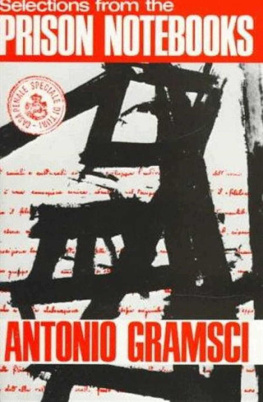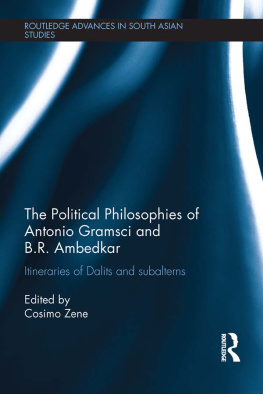George Hoare - An Introduction to Antonio Gramsci: His Life, Thought and Legacy
Here you can read online George Hoare - An Introduction to Antonio Gramsci: His Life, Thought and Legacy full text of the book (entire story) in english for free. Download pdf and epub, get meaning, cover and reviews about this ebook. year: 2015, publisher: Bloomsbury, genre: Politics. Description of the work, (preface) as well as reviews are available. Best literature library LitArk.com created for fans of good reading and offers a wide selection of genres:
Romance novel
Science fiction
Adventure
Detective
Science
History
Home and family
Prose
Art
Politics
Computer
Non-fiction
Religion
Business
Children
Humor
Choose a favorite category and find really read worthwhile books. Enjoy immersion in the world of imagination, feel the emotions of the characters or learn something new for yourself, make an fascinating discovery.
- Book:An Introduction to Antonio Gramsci: His Life, Thought and Legacy
- Author:
- Publisher:Bloomsbury
- Genre:
- Year:2015
- Rating:4 / 5
- Favourites:Add to favourites
- Your mark:
- 80
- 1
- 2
- 3
- 4
- 5
An Introduction to Antonio Gramsci: His Life, Thought and Legacy: summary, description and annotation
We offer to read an annotation, description, summary or preface (depends on what the author of the book "An Introduction to Antonio Gramsci: His Life, Thought and Legacy" wrote himself). If you haven't found the necessary information about the book — write in the comments, we will try to find it.
George Hoare: author's other books
Who wrote An Introduction to Antonio Gramsci: His Life, Thought and Legacy? Find out the surname, the name of the author of the book and a list of all author's works by series.
An Introduction to Antonio Gramsci: His Life, Thought and Legacy — read online for free the complete book (whole text) full work
Below is the text of the book, divided by pages. System saving the place of the last page read, allows you to conveniently read the book "An Introduction to Antonio Gramsci: His Life, Thought and Legacy" online for free, without having to search again every time where you left off. Put a bookmark, and you can go to the page where you finished reading at any time.
Font size:
Interval:
Bookmark:
An Introduction to
Antonio Gramsci
An Introduction to
Antonio Gramsci
His Life, Thought and Legacy
GEORGE HOARE AND
NATHAN SPERBER
Bloomsbury Academic
An imprint of Bloomsbury Publishing Plc

T hroughout, references to Gramscis prison writing follow the international standard: notebook number, according to the 1975 Italian critical edition (edited by Valentino Gerratana), followed by number of note. In this way, notebook (quaderno) 12, note 3 becomes Q123. We have also given page references to one of the English anthologies of Gramscis writings, where possible. In referring to Gramscis writings we have used the following abbreviations:
SPN: | Selections from Prison Notebooks, edited and translated by Quintin Hoare and Geoffrey Nowell-Smith (London: Lawrence and Wishart, 1971). |
SPWI: | Selections from Political Writings (19101920), edited by Quintin Hoare and translated by John Mathews (London: Lawrence and Wishart, 1977). |
SPWII: | Selections from Political Writings (19211926), edited and translated by Quintin Hoare (London: Lawrence and Wishart, 1978). |
LP: | Letters from Prison by Antonio Gramsci, edited and translated by Lynne Lawner (London: Quartet, 1979). |
SCW: | Selections from Cultural Writings, edited by David Forgacs and Geoffrey Nowell-Smith and translated by William Boelhower (London: Lawrence and Wishart, 1985). |
FSPN: | Further Selections from the Prison Notebooks, edited and translated by Derek Boothman (London: Lawrence and Wishart, 1995). |
GR: | The Gramsci Reader: Selected Writings, 19161935, edited by David Forgacs (New York: New York University Press, 2000). |
I t may be asked how we can read Gramsci today. Any answer to this question is inevitably complicated by the emergence since his death, and particularly in the English- and Italian-speaking academic communities, of a veritable Gramsci industry with a great many different Gramscis. Thus, we see a Gramsci in International Relations, in Cultural Studies, in Political Theory, in Literary Theory and in Postcolonial Studies. There is a Gramsci used by the Right and one claimed by the Left.
In place of these diverse and split Gramscis, we instead argue for a unified and consistent Gramsci, a Gramsci essential for critical thought today. This unified Gramsci is centred on his attempt to develop the tools and resources he needed to understand his own historical situation in a way that would simultaneously renew and extend Marxism. We contend that the challenge Gramsci presents us is not the doctrinaire establishment of the precise meaning of Gramscian concepts, but rather a textual and philological fidelity allied with an understanding of the essential rhythm of his thought. We propose a challenge to the reader of thinking through Gramsci: of using Gramscis thought to think through to unpack and to begin to understand the historical situation in which we find ourselves today.
When reading Gramsci we should begin with the concrete: Gramscis analyses of intellectuals, education, journalism and common sense provide a number of starting points for the analysis of ideology in late capitalism; his understanding of the State and civil society helps us comprehend the constellations of power operating today. Thinking through Gramsci must be dialectical, flexible, open-minded and generative, attempting to open new avenues rather than discover new dead ends. At the same time, thinking through Gramsci involves investigating how concrete forms of thought and practice are linked to politics Gramscis conceptual and political horizon remains that of hegemony, or the methods of organizing consent that involve both material and ideological elements. We have not yet moved beyond this horizon. We must also take lessons from Gramsci in the matters of personal courage and conviction: those who would think critically must attempt to generate an unbending fidelity to the intellectual and practical consequences of their ideas. Finally, the task Gramsci sets us is nothing less than that of forming a new common sense. Gramsci sees in all his analyses that superstructures do all they do for capital to put it another way, capitalism is glimpsed as a whole form of social life. The alternative to capitalism has to be a whole form of social life, too. Therefore, as much as we need Gramscis famous pessimism of the intellect, optimism of the will, we also need his idea that the goal of thought and practice is to trace the thread of a new conception of the world and to struggle to bring it into being. This is Gramscis core lesson for our times.
This book is broken down into four parts. The first gives an overview of Gramscis biography, intellectual development and some of his pre-prison writing (). Gramscis life shows him to be one of the most determined, uncompromising and depending on your reading tragic and/or inspiring figures in the history of the Left.
The second examines in detail Gramscis thought as developed in his Prison Notebooks. It is composed of four chapters that deal, successively, with Gramscis thought on culture ( We think it likely that most readers coming to Gramsci will use this collection, and moreover we judge it to be an excellent (if, of course, partial) selection and translation of many of Gramscis most interesting, difficult and thought-provoking prison notes. Our structure should also be useful to those coming to Gramsci through other avenues. After three substantive chapters that correspond more or less closely to the three parts of SPN, the chapter on hegemony then looks to draw together strands from the previous chapters and present a synoptic account of how we might be able to understand Gramscis most famous concept and its interrelations with the other key points of his thinking. Hegemony runs like a thread through Gramscis notebooks and, in our argument, also forms the basis of Gramscis understanding of history and of political strategy. We hope that the present volume, and in particular Part Two, might serve usefully as a companion to SPN, explicating some of Gramscis most difficult concepts and placing them in tentative relation to one another.
The third part looks to apply Gramscis thought to two contemporary questions: the possibility of a critical analysis of common sense in Political Theory (). In these chapters, we attempt to develop and extend Gramscis thought by applying it to what we take to be problems of contemporary significance and interest. In so doing, we look to illustrate what we believe to be a Gramscian method of philosophical and political analysis both in the sense of following methodological precepts suggested by Gramsci and also in the sense of developing new theoretical insights (as Gramsci did) from the analysis of social relations as they exist and have developed historically. Finally, we intend Part Three to stand in support of a more general argument that Gramscis thought is, crucially, usable today as a tool for those who want to think critically about society.
). First, we place Gramsci in the trajectory of twentieth-century Marxist thought and consider his influence on the Italian communist movement. We then look to chart Gramscis relation to four intellectual fields particularly influenced by his thought: Cultural Studies, post-Marxism, Postcolonial Studies and International Political Economy. This exploratory map of Gramscis intellectual legacy suggests that Gramscis influence on contemporary critical thought is a central one, especially for those concerned to think about the relations between historical context and the forms of domination in a given society, and ultimately between culture, politics, philosophy and power taken in their widest senses.
Next pageFont size:
Interval:
Bookmark:
Similar books «An Introduction to Antonio Gramsci: His Life, Thought and Legacy»
Look at similar books to An Introduction to Antonio Gramsci: His Life, Thought and Legacy. We have selected literature similar in name and meaning in the hope of providing readers with more options to find new, interesting, not yet read works.
Discussion, reviews of the book An Introduction to Antonio Gramsci: His Life, Thought and Legacy and just readers' own opinions. Leave your comments, write what you think about the work, its meaning or the main characters. Specify what exactly you liked and what you didn't like, and why you think so.

